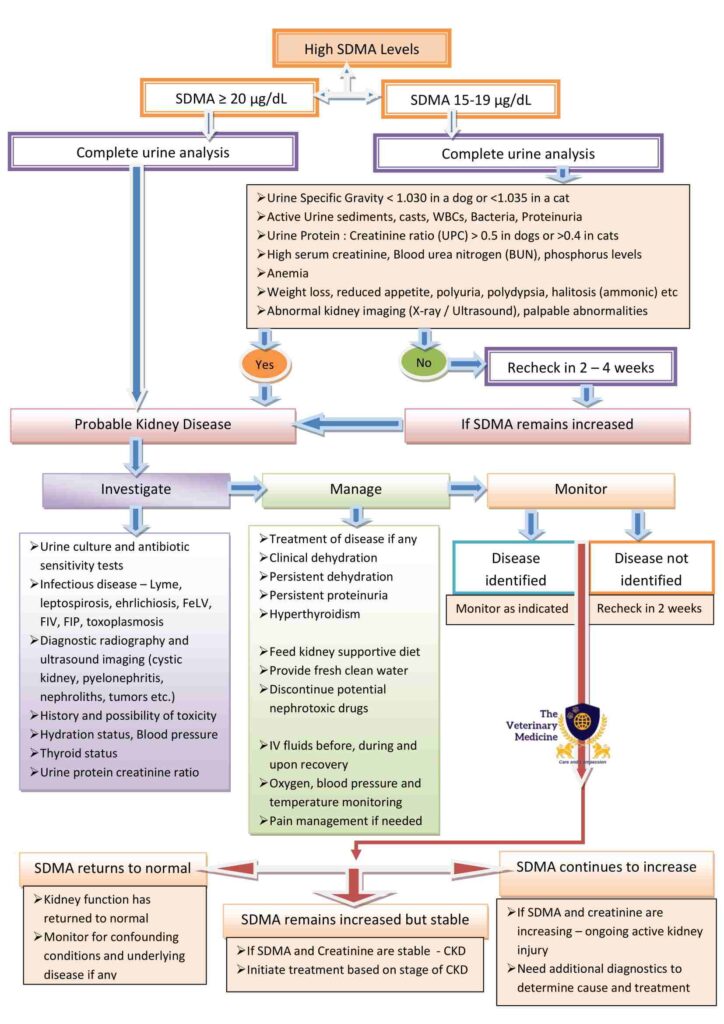SDMA (Symmetric dimethylarginine)
More Reliable Tool for the Diagnosis of Kidney Health in Dogs and Cats
What is SDMA?
SDMA or Symmetric dimethylarginine is a biomarker and amino acid arginine that contains two methyl groups in a symmetrical orientation which is excreted by kidneys. It gives more accurate and reliable value of glomerular filtration rate (GFR) than creatinine in dogs and cats. SDMA was first identified in human urine in the year 1970. The first clinical study in veterinary patients was published in 2008 for SDMA levels associated with CKD (Chronic Kidney Disease) in cats.
Why SDMA is recommended for dogs or cats?
It helps in the early detection of the kidney disease in dogs and cats. It can diagnose kidney disease in dogs and cats months or years earlier than the standard screening technologies (blood chemistry parameters, blood urea nitrogen, creatinine and urine specific gravity). In research it has shown in one animal 4 years early detection of the kidney problem. SDMA has 91% specificity and 100% sensitivity for kidney disease in dogs and cats. In fact about one out of ten senior dogs will have some form of kidney disease over their lifetime while it is 1 out of 3 in senior feline patients over age 15. At early stages kidney disease has no visible signs and cats actually can hide disease even at advance stage so pets suffering from kidney disease may appear normal.
Increased serum SDMA levels
Serum SDMA concentration increases in the case of decreased kidney function. It can be due to acute kidney injury (AKI) or chornic kidney disease (CKD) in dogs and cats. It is slightly higher in growing puppies than adult dogs.
SDMA v/s Creatinine – Reliability
It is more specific and less affected by other body conditions with weight and muscle loss, advanced age and disease state. It does not appear to be absorbed in the renal tubules of influenced by many non-renal factors. Creatinine is not useful in diagnosing kidney health until almost 75% or kidney function is lost but SDMA does it as early as 25% both in chronic and acute kidney injury. In cases of untreated hyperthyroidism increased GFR and loss of muscle mass is common which can hide underlying CKD but SDMA is only slightly affected by hyperfiltration and not affected by lean body mass. This makes it a more reliable tool for diagnosis of CKD (chronic kidney disease).
It is very uncommon when creatinine is increased and SDMA concentration is normal. Haemolysis can result into decreased SDMA serum concentrations. Creatinine can be increased in case of muscular dogs and postprandially though having normal kidney function.
Creatinine is complementary to SDMA for the evaluation of kidney health. A complete history, blood profile including CBC, serum electrolyte profile with kidney function parameters, urine analysis (including urine protein creatinine ratio and specific gravity), physical examination and radiodiagnosis/ultrasound is helpful in the complete evaluation of kidney health. CKD cannot be reversed or cured but treatment and management aimed at reducing the contributing factors and symptoms can slow its progression.
Benefits of SDMA and early diagnosis of CKD
Early diagnosis of CKD helps in the investigation of the cause of kidney disease and management. Conditions like infections, obstruction, exposure to nephrotoxic drugs can be treated at early stage and assessment of hydration status, blood pressure and thyroid status cab be made.
Future insult to the kidneys can be avoided by taking precautions if diagnosed early. Treatment can be initiated and can be monitored easily with regular tests. Serum SDMA helps in the prediction of the impact of the hyperthyroidism treatment on kidney function test in cats and helps in identifying which cat will become azotemic after treatment.
Sample:
Serum or heparinized plasma can be used for the performing test.
Stability:
Both in cats and dogs, it is stable for one week at room temperature. Stable over a year at -20°C or -80°C and for two weeks at 4°C.
Reference ranges of serum SDMA
Cat / Kittens: 0-14 µg/dL
Puppies: 0-16 µg/dL
Dogs: 0-14 µg/dL

SDMA reference range in kittens and adult cats is almost similar. The adult range can be used in kittens. Serum SDMA reference levels in puppies have been determined slightly higher than the adult. It is mainly during the rapid growth phase (rapidly growing puppies up to 14-16 µg/dL) and can be determined again as the growth phase slows down. In cases of high SDMA levels, urine analysis and other evidence of kidney disease can be checked in puppies. SDMA level normalizes as the puppy reaches adulthood. Toy breeds attain adulthood earlier than giant breeds. The exact cause of high reference level can’t be explained in puppies but physiological roles for protein arginine methylation, protein translocation, DNA repair, mRNA splicing, transcriptional control, signal transduction are postulated to be a reason of an increase in SDMA levels. High SDMA concentrations always do not mean renal dysfunction or the renal dysfunction was transient.
In dogs and cats lean body mass do not appear to influence serum SDMA levels. It has shown that in humans dietary arginine has no effect on serum SDMA concentrations so it remains unaffected with diet.
Serum SDMA to creatinine ratio greater than 10 in dogs and cats were associated mortality within 1 year. So it may have good prognostic value. Dogs or cats having high serum SDMA concentrations (>16 µg/dL) along with high urine specific gravity i.e. > 1.040 more likely to have prerenal azotemia if dehydrated. Cats and dogs having borderline increase in serum SDMA and creatinine concentration should be tested again after two weeks of initial screening and every three months to assess the renal function performance and stability. Other tests should also be performed to ensure potential renal disease and associated complications.
Test kits also available form bionote in the name of Vcheck SDMA for feline and canine SDMA while IDEXX SDMA kits are the first choice worldwide.
Click Here to Read About Phosphate Binders for Chronic Kidney Disease Management
References:
Ernst, R. et al. 2018. Comparative performance of IDEXX SDMA Test and the DLD SDMA ELISA for the measurement of SDMA in canine and feline serum. PLoS One. 2018 Oct 15;13(10):e0205030. doi: 10.1371/journal.pone.0205030. eCollection 2018.
Hall, J. A. et al. 2014. Comparison of serum concentrations of symmetric dimethylarginine and creatinine as kidney function biomarkers in healthy geriatric cats fed reduced protein foods enriched with fish oil, L-carnitine, and medium-chain triglycerides. Vet J 2014; 202:588-596.
Relford, R. et al. 2016. Symmetric Dimethylarginine: Improving the Diagnosis and Staging of Chronic Kidney Disease in Small Animals. Vet Clin North Am Small Anim Pract. 2016 Nov;46(6):941-60. doi: 10.1016/j.cvsm.2016.06.010. Epub 2016 Aug 5.
Rytlewski, K. et al. 2005. Effects of prolonged oral supplementation with L-arginine on blood pressure and nitric oxide synthesis in preeclampsia. E J Clin Invest 2005; 35:32-37.
Yeramilli, M. et al. 2015. Prognostic value of symmetric dimethylarginine to creatinine ratio in dogs and cats with chronic kidney disease. Proc ACVIM Forum, 2015. acvim.org, accessed 2015.





